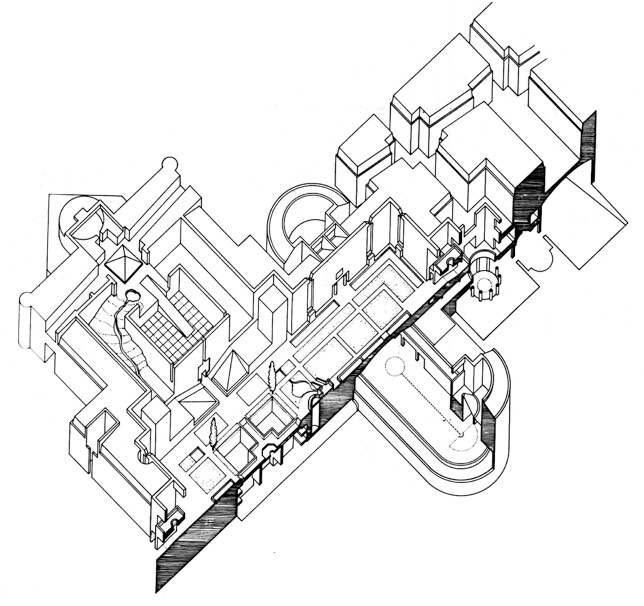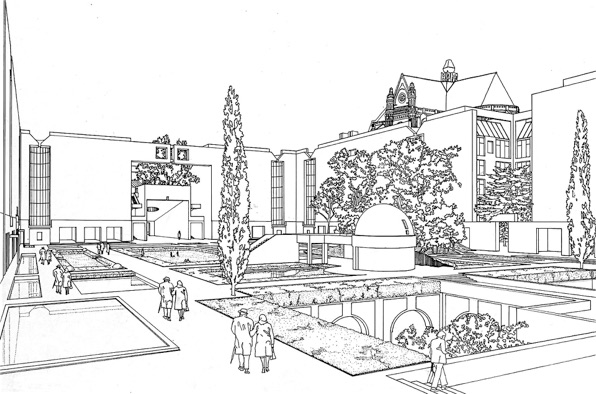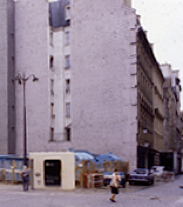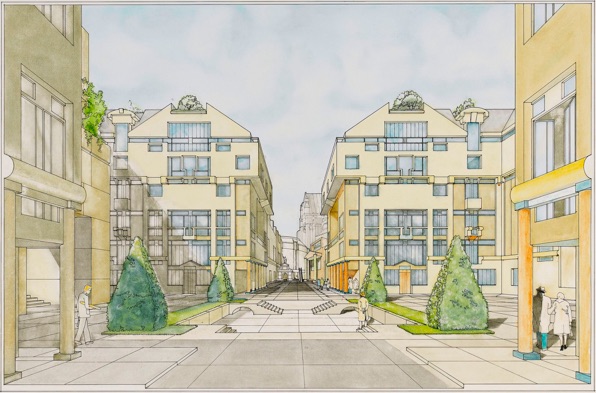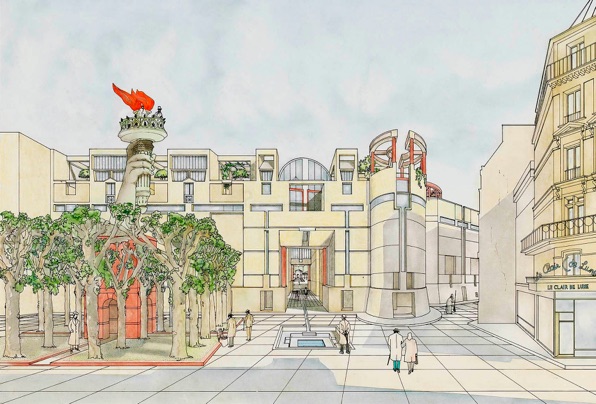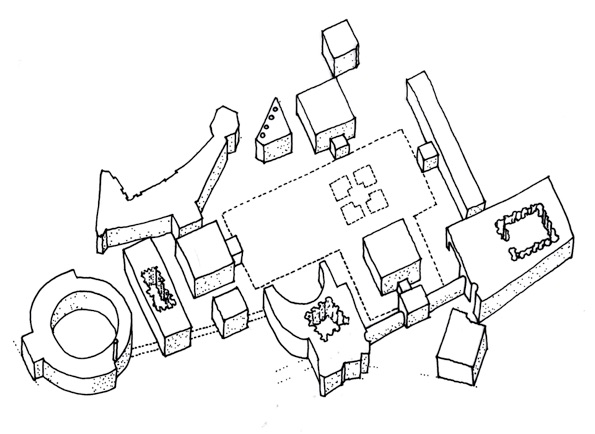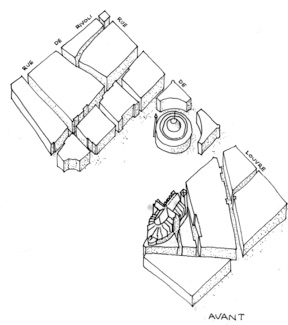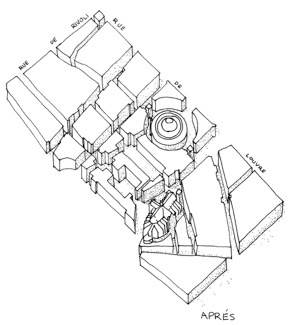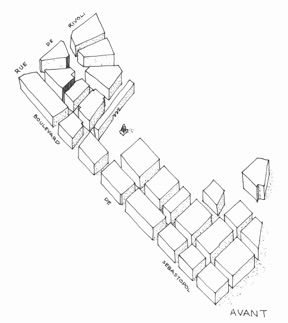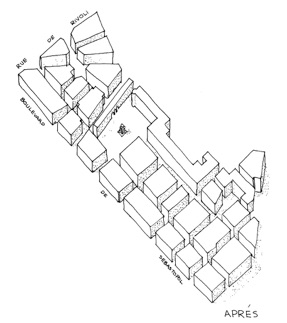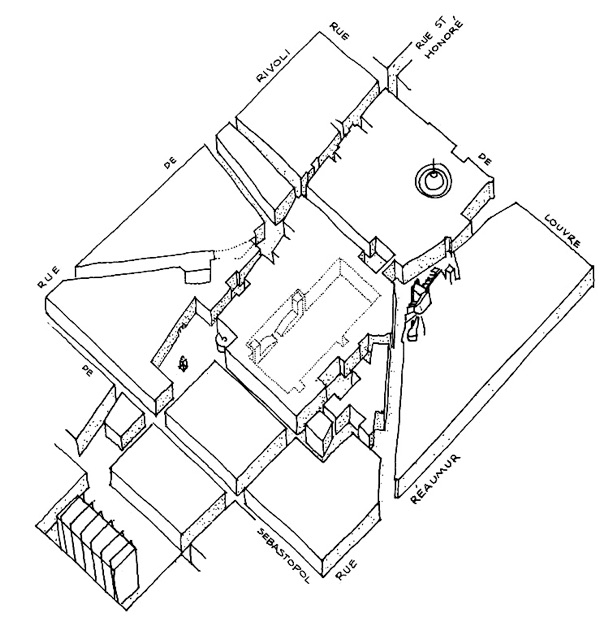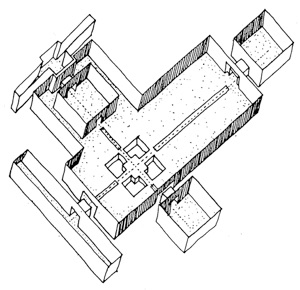-
19)Cutaway view showing underground forum, athletic track, and theaters below

This composite garden precinct is in effect a hidden and perhaps mysterious place, meant to relate to the city as a whole. In a sense the form of the space is inconclusive - its axes are not resolved by monumental buildings or terminating facades but in gates, which are themselves thresholds locating the transition point between inside and out. It is an outdoor interior that requires a conscious choice to enter. The need for deliberate decision, the intended isolation from normal functions and activities and the ambiguity of external boundaries present a challenge to the experience. Perhaps a sense of speculation will be promoted about the larger question, the nature of urban form and the significance of public space.
What are the Shapes of Urbanity - The Lessons of Paris
Although this article discusses our specific project for the Les Halles site in Paris, it is really about the general intentions and purposes of Urban Design. These are simple: the continued reconstruction and future building of the dense, diverse, urban city. This has proved harder to achieve than expected, as we can see in most of the new cities being built around the world today (2017). A human scaled urban fabric with proportional defined public space is difficult to find in the latest projects designed in an endless Anti-Space.
How to achieve the Aim of Urbanism? The Les Halles Project and this article were our own first attempts at articulating the “Means” toward this end.
-
18)View from the north gate overlooking the shopping Forum which has been remodeled into a grotto below the quiet, “hidden” public garden. In the background is the outdoor framed exhibition space of the Museum of the City
Postscript
The Museum of the City drawn by us in 1979 appears as a public building that protrudes south into the urban fabric. Its roof faces back becoming a terrace overlooking the interior garden precinct. It seemed an unlikely but symbolic program proposal for Paris at the time.
However, on a recent visit to China in 2012, we encountered newly built museum buildings of this scale in both Shanghai and Beijing that were dedicated to the promotion of urban design, history, and the planning of their cities. This seems to confirm the prescience of our proposal for a similar museum for Les Halles.
-
f.The form of the public precinct
The alternative strategy was to develop this whole area of the site as a composite precinct – an urban element that is characterized by its ability to perform in more complicated and deliberately ambiguous ways. Its interior is a figural armature of volumetric space manifested in different ways according to various peripheral conditions. To the south the exhibition building, which is part of the precinct, presents itself as a principal facade somewhat like the walls of an ancient Chateau Fort (figure 13). To the north and west, however, the precinct’s object quality is suppressed to integrate it with the surrounding texture. Its walls become housing and its configuration is shaped to correspond with the form of adjacent streets and squares. The entire precinct is intended as a symbol for the idea of city, conceived as a traditional walled town, but in a reversed poetic conception. Historically the city was contained within its walls, while the garden and landscape were located outside.
The interior walls of this space are made like the exposed party walls on the edge of a construction site after demolition – blank, stucco, and with profiles of Mansard roofs in section (figure 15, figure 16). Vertical slots for residential light wells provide collective windows for the surrounding buildings without being represented in the garden as individual facade elements. The elevation of these walls belongs only to the surface of the public space. It signifies the condition in between the actual elements of the city.
In this way the garden space remains generalized and does not assume a proprietary relationship to its immediate adjacencies. Access to these buildings is external to the garden via the street (figure 12, figure 14). The experience of the public space becomes a radical juxtaposition – its form and definitive surfaces are composed of an ordinary element that is normally hidden between buildings. Its exposure suggests the events of transition and change.





-
16)Inside the Garden Precinct looking toward west gateway. A public space carved out of the inner city of party walls.
-
15)Existing party walls exposed near the Les Halles site.
-
e.The surrounding urban spaces
There are ten new urban spaces and two restored ones around the perimeter of the main sequestered garden precinct (250 feet x 600 feet). They create a variety of places at differing scales and proportion that punctuate sequences of movement along the streets around the garden precinct (figure 11). There is a repetitive 140 feet x 140 feet module to the square vestibules with gates leading into the Precinct Garden (figure 12). Two are residential places, the third a room in the museum ground floor that emerges out on the roof as an object of 140 feet x 140 feet. The square of trees at the west of the Passage/Galleria is 140 feet x 140 feet and fits inside the ring of trees around the Fountain of the Innocents on the other side (figure 13).
-
12)140’ x 140’ residential square forming north entrance to garden. Gate to the left and transept tower down the street in the distance.
-
13)Square of pollarded Plane trees in front of the Museum of the City designed like a French Chateau Fort. The galleria penetrates through to the fountain on the other side. Note the exposed party wall on the right.
-
11)A variety of urban spaces surround the garden precinct (dotted line).




In part, the location and size of the inner precinct space results from the specific requirements of completing these textures, but it is also a consequence of other site conditions. These suggest that the present site must be divided into several sub-compositions that limit the size and location of public spaces. Therefore, the solution for the major plan element must be smaller than the available site.
-
d.Existing axes
The existing axis between the Bourse and the Forum is in itself a dilemma. This arbitrary alignment is left over from the design of the Baltard’s market halls and its continued accentuation produces a false emphasis between inappropriate things – the back of the Bourse and the light well for an underground shopping center. To emphasize this axis would make them dominant symbols.
To avoid extending the Bourse’s influence, it is more appropriately confined to its own space and defined by a limited local context. This stabilizes its position and reinforces its frontal orientation toward the Rue du Louvre. Connections to the rear are deliberately made off axis, one extending obliquely from the column, the other connecting through the Hotel courtyard to the facade of Saint-Eustache as an extension of the Rue du Jour. Similarly, this east/west axis is eliminated in the Forum light well. The Forum is remodeled into a series of grottoes that appear to be sunken parterres from the surrounding garden. Its visible dimensions are made to serve the space above, while a portion of it is enclosed under a skylight to form a central hall for the shopping levels below (figure 18).
Finally, the north/south axis from the Pont Neuf to the transept tower of Saint-Eustache must be maintained. This is the primary visual link beyond the site to the Seine. To intercept this sequence with a major destination before its logical termination at the church is difficult to justify – it seemed logical then to confine the sequestered space to one side of this important visual axis (figure 14).
The location of the major new metropolitan space is derived in part from these considerations, but its particular characteristics and form are another matter. The solution seemed to lie beyond simple typological choices.
On the one hand, a space on this scale, opened in a conventional way to receive the principal surrounding streets, seemed to demand a more significant building or event than is available to justify it. On the other hand, a more secluded, residential square would bind the area too closely to its immediate surroundings, restricting broader interpretations for the entire city.
Our solution was to to provide both; a series of peripheral local squares and a central main space (figure 11). In this case, the city walls contain the structured space of a protected garden, while the city appears to expand limitlessly outside. This connotation of a historical or archaeological city, carved out of the interior of existing blocks, is amplified by restricting access to the garden to four gates located at the cardinal points. The garden is structured by this primary cross-axis like the original Roman town or Imperial Forum. It is both garden and urban space developed as a combination of flat parterres floating within a moat, and a series of terraces stepping up to the south eventually reaching the roof level of the external city and providing a view back to the Ile de la Cité and the tower of Notre Dame (figure 6).
-
9)The round Bourse and Saint-Eustache with no context. Appropriate settings provided for each.
-
10)The blocks flanking the Place des Innocents are joined in a restored space for the fountain.
To the east, the existing group of blocks is at present divided by the gap of the Place des Innocents. They are joined in a new field that establishes a broader boundary formed by a proposed bent wall of housing wrapping the inner precinct. The north and south groups of blocks thereby encompass the Place des Innocents that is restored to its original historic size. The Rue Lescot, formerly the eastern edge of the market site, can now be understood as a new center penetrating the middle of the Place des Innocents and linking a sequence of spaces running north from the Rue de Rivoli to the Rue Turbigo. In addition, the northern texture is expanded around the air conditioning plant serving the shopping center below, concealing it from within the site (figure 10).
LES HALLES, The Site in Particular
The specific problem at Les Halles however, is not entirely generic. It requires not only a reweaving of the city texture but also the introduction of major public space of metropolitan scale. This is justified by the area’s history, its central location (in correspondence with the Ile de la Cité) and its compounded transportation connections.
It is a symbolic place and a singular destination that warrants a unique formal identity. These two objectives, the general reconstruction of the city fabric and a major public space, are potentially contradictory on a site of this size and proportion. It is the accomplishment of both which seems to be the unique challenge of Les Halles. The following description outlines the objectives and intentions of this particular scheme.
The empty site is 1,000 feet long and 500 feet wide at its narrow end.
-
a.Reinforcement of the continuities beyond the site
The surrounding rectangular district is actually the enlarged field of composition for the Les Halles site (figure 8). Its boundaries are emphasized by the solidification of the center, eliminating through-connections and reinforcing local ones. The diagonal streets are not connected to each other or conventionally resolved but are individually terminated and diffused. This contributes to the impression that perhaps the new Center Precinct may have been the generator of influences rather than the receiver (figure 8a).
-
b.The suppression of the existing site boundaries
The existing north and south boundaries of the site are eliminated as through-connections so that the continuous linkage of spaces along Rue Saint-Honoré becomes primary. A new sequence is emphasized in the blocks above the Rue de Rivoli. The Rue Saint-Honoré is continued from the front of the Palais Royal through the proposed galleria/exhibition building into the Place des Innocents, where it continues to the Rue Berger and the Centre Pompidou (figure 11, figure 13).
-
c.Continuity of texture
The discontinuity of these boundaries (Rue Rambuteau and Rue Berger) also facilitates a more complex north/south continuity of new textures. At the western end, a new field of blocks and spaces joins the areas below and above the site through the creation of a new residential neighborhood. At the eastern end, a new street forms a clear boundary to the existing blocks.
To the west, new urban texture is inserted to reconnect the city fabric from north to south that allow separate treatments of the two as local monuments; a side space for Saint-Eustache’s transept tower and a circular completion around the Bourse (figure 9).
-
8)a. The Center Precinct of Inner Public Garden with its four gateway entrances.
Circular enclosure of Bourse
Axis through to transept of Saint-Eustache with public athletic facilities below
Garden precinct
View of north gateway entrance with shopping “Forum” and train station below
-
14)Long section looking north.
-
8)Diagram of the rectangular district of Les Halles, illustrating the linkages into the city beyond the site.
Photo: Andrew Fare
Copyright 2018 Peterson Littenberg Architecture and Urban Design 131 East 66th Street, New York, NY 10065
